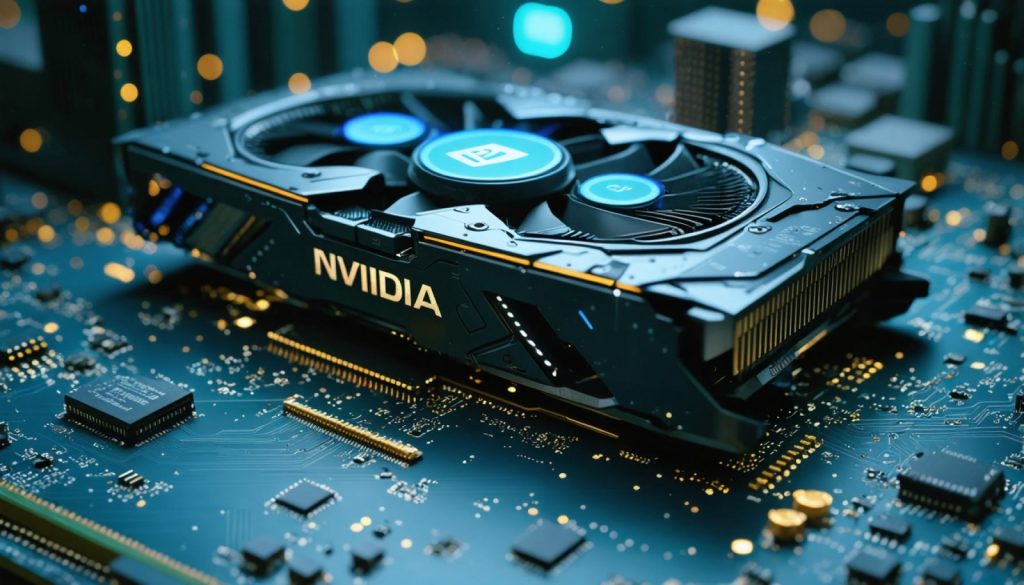
- Nvidia unveiled the Blackwell Ultra GPU architecture, boosting AI reasoning tasks with enhanced memory capacity and performance.
- The Rubin architecture, succeeding Blackwell, aims to power AI data centers with higher efficiency.
- The introduction of Isaac GR00T N1, a customizable platform for humanoid robotics, marks a leap in robotic development.
- Nvidia’s new Accelerated Quantum Computing Research Center in Boston highlights its entry into quantum computing.
- Despite technological advancements, real-world AI applications at GTC 2025 were notably absent, casting uncertainty over practical implementations.
- Nvidia faces competitive pressure from AMD and China’s drive toward technological self-reliance.
- The gaming sector, once a core focus, saw reduced emphasis, despite its potential for AI-driven advancements in virtual worlds.
- Nvidia must balance innovating against competitors and leveraging technology to solve current issues for sustained relevance.
Under the glimmering lights of GTC 2025, Nvidia once again cemented its place at the forefront of AI and accelerated computing. The event was a showcase of technical prowess and futuristic ambition, with groundbreaking announcements promising to redefine the landscape of artificial intelligence.
At the heart of the conference, Nvidia unleashed the Blackwell Ultra GPU architecture, an evolutionary leap designed to tackle the most demanding AI reasoning tasks. This new architecture not only elevates memory capacity but also cranks up performance metrics, illustrating Nvidia’s relentless drive to stretch the horizons of AI computing. Adding to this symphony of innovation was the introduction of the Rubin architecture, the anticipated successor to Blackwell. Poised to fuel AI data centers with unprecedented efficiency, Rubin promises another chapter in Nvidia’s saga of annual breakthroughs.
Venturing further into groundbreaking territory, Nvidia revealed the Isaac GR00T N1, a pioneering foundation model for humanoid robotics. The world paused to take in this marvel—an open, infinitely customizable platform aimed at catalyzing the development of versatile, general-purpose robots. In a nod to the future’s technological frontier, Nvidia announced the birth of the Nvidia Accelerated Quantum Computing Research Center in Boston, marking its earnest foray into quantum computing.
Yet amidst all the triumph, Nvidia faces the inherent vulnerabilities of market leadership. As the grand narratives of AI and accelerated computing unfold, there’s palpable tension: a looming complacency that haunts empire builders as they gaze at the precipice of their next innovation.
While the Robotics sector dazzled attendees with its promise-filled narratives, the conspicuous absence of real-world AI applications cast a shadow over the proceedings. Previous GTCs brimmed with success stories, but this year, attendees were left contemplating the tangible applications of Nvidia’s technology—particularly beyond the entertainment allure of humanoid machines.
Further complicating Nvidia’s roadmap are the sharpened teeth of competition. AMD continues its ascent, nibbling away at Nvidia’s market share with compelling hardware suited for data centers. On the other side of the globe, China’s ambitious drive towards technological self-reliance spawns formidable adversaries like Huawei, eager to assert dominance in AI chips amidst geopolitical tremors.
The impending shift into quantum computing adds another layer of intrigue to Nvidia’s journey. In this fiercely contested arena, giants like IBM and Google stand ready as Nvidia embarks on its odyssey into the realm of quantum-classical hybrids, promising computational revolutions that could reshape industries.
Conspicuous by its silence, the gaming sector, once a star of GTC, found itself relegated to the periphery. AI’s transformative potential for more lifelike virtual worlds and non-player characters remains an enticing yet inadequately tapped frontier—a reflection, perhaps, of Nvidia’s recalibrated priorities.
Nvidia faces an inflection point. To harness the swirling winds of AI evolution, it must refocus on a dual mandate: to wield technology as a tool for solving today’s challenges and to innovate ceaselessly against a backdrop of rising competitive tides. A return to roots, recognizing gaming as a core catalyst of change, might crown their legacy with enduring relevance.
As visions of AI and quantum breakthroughs illuminate GTC 2025, the echoes of past successes and the call of future potential weave a tapestry of both opportunity and urgency—demanding more than just promises of speed and power. It’s a clarion call for Nvidia to navigate this spectrum with strategized foresight and ingenuity, anchoring its legacy as more than a tech titan, but as a steward of transformative impact.
Nvidia Shines at GTC 2025: Breaking Down the AI Revolution and What’s Next
Nvidia’s Latest Announcements: Transforming AI and Computing
Nvidia’s GTC 2025 delivered several groundbreaking announcements that look set to redefine the landscape of artificial intelligence (AI) and computing. Highlighted by the launch of the Blackwell Ultra GPU architecture and the Rubin architecture, Nvidia continues to push the boundaries of technology. These innovations in AI computing have sparked considerable interest and excitement.
Blackwell Ultra GPU & Rubin Architecture
– Performance and Capacity: The Blackwell Ultra architecture signifies a leap in both memory capacity and processing power. This is expected to significantly boost the performance of AI tasks, making them faster and more efficient.
– Rubin’s Promise: Following Blackwell, the Rubin architecture is geared toward optimizing AI data centers, enhancing their capacity to manage vast data loads with unmatched efficiency.
Isaac GR00T N1: A New Era for Robotics
– Humanoid Robotics Platform: Nvidia’s Isaac GR00T N1 foundation model aims to revolutionize humanoid robotics with its open and customizable platform. It promises a future where general-purpose robots could tackle diverse tasks across industries.
Exploring Quantum Computing
– Quantum Frontier: Nvidia’s entry into quantum computing is marked by the launch of its Accelerated Quantum Computing Research Center. This strategic move positions Nvidia alongside IBM and Google in the pursuit of quantum-classical hybrid systems.
Market Dynamics and Competition
Rising Competition
– AMD and China’s Tech Ambitions: Nvidia faces stiff competition as AMD continues to gain traction in data center hardware, while Chinese companies like Huawei strive to achieve technological self-reliance, affecting Nvidia’s global market share.
Gaming Sector’s Changing Role
– Shifting Priorities: While gaming has historically been a core component of Nvidia’s strategy, it took a backseat at GTC 2025. Nvidia’s focus appears to be expanding, leveraging AI for broader applications, though the potential for AI-enhanced gaming remains largely untapped.
Questions and Insights
What Does This Mean for AI Development?
– Advanced Capabilities: The new architectures could unlock advanced AI capabilities, enabling more complex neural networks and improving AI reasoning and decision-making.
How Will Quantum Computing Impact Industries?
– Revolutionary Potential: Quantum computing could dramatically accelerate problem-solving for industries by handling complex calculations much faster than current classical computers.
Actionable Recommendations
1. Stay Informed: For businesses and developers, keeping abreast with Nvidia’s latest technologies can provide insights into leveraging cutting-edge GPUs and quantum solutions.
2. Explore Robotics Applications: Organizations could begin exploring the potential applications of Nvidia’s new robotics platform to enhance operational efficiency.
3. Prepare for Quantum Leap: Companies should consider investing in talent and infrastructure that are ready to capitalize on quantum computing advancements.
4. Leverage AI in Gaming: Developers in the gaming industry can explore how AI can enhance gaming experiences, tapping into a relatively untapped aspect of Nvidia’s current offerings.
Related Links
– Visit Nvidia’s Official Page
Nvidia’s announcements at GTC 2025 underscore the company’s commitment to technological advancement, even as it faces emerging challenges and competitions. By leveraging its innovations and expanding its focus, Nvidia is positioning itself to remain a key player in the rapidly evolving tech landscape.



